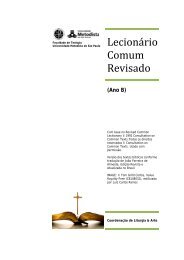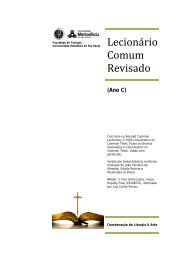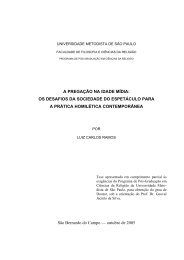- Page 1 and 2: UNIVERSIDADE METODISTA DE SÃO PAUL
- Page 3 and 4: AUTOBIOGRAFIA Nasci quando obscuras
- Page 5 and 6: Por isso, criei coragem e, apoiado
- Page 7 and 8: Fides ex auditu (Romanos 10.17) Pal
- Page 9 and 10: AGRADECIMENTOS Esta é uma página
- Page 11: RAMOS, Luiz Carlos. A Pregação na
- Page 15 and 16: II.2.2.2 Argumentação psicológic
- Page 17 and 18: INTRODUÇÃO A Pregação na Idade
- Page 19 and 20: zem inteligíveis. Trata-se de um m
- Page 21 and 22: “império das emoções” e o pr
- Page 23 and 24: a discursiva. Finalmente, quanto à
- Page 25 and 26: uscará, entretanto, elaborar uma h
- Page 27 and 28: I.2 A homilética antes da homilét
- Page 29 and 30: vista social e ideológico, temos u
- Page 31 and 32: discurso vai além da mensagem text
- Page 33 and 34: mesmo, de sua situação ou de sua
- Page 35 and 36: fala em público (diante do públic
- Page 37 and 38: Ainda para Monloubou, “o ato simb
- Page 39 and 40: de vista da capacidade comunicativa
- Page 41 and 42: (no sentido do termo grego charis,
- Page 43 and 44: I.3.2.1 Pedro Segundo Pattison 64 ,
- Page 45 and 46: 38 Respondeu-lhes Pedro: Arrependei
- Page 47 and 48: Para Pattison, “nenhum outro [ap
- Page 49 and 50: epresentada por Jerônimo, Ambrósi
- Page 51 and 52: de Símaco, prefeito de Roma, obtev
- Page 53 and 54: portam a Anselmo (1033-1109) e Lanf
- Page 55 and 56: herege, foi um dos primeiros exempl
- Page 57 and 58: O espírito dos místicos imprimiu
- Page 59 and 60: Segundo Niebhur e Williams, a funç
- Page 61 and 62: pregação, culto e espaço públic
- Page 63 and 64:
matória. Daí a centralização ai
- Page 65 and 66:
trutura: método, e este sempre mud
- Page 67 and 68:
pensador e o dom do orador” 152 .
- Page 69 and 70:
ses, escoceses, e estadunidenses, p
- Page 71 and 72:
edade, e a sociedade não pode ser
- Page 73 and 74:
Na América Latina, particularmente
- Page 75 and 76:
série de publicações, que contin
- Page 77 and 78:
As dificuldades enfrentadas pela ho
- Page 79 and 80:
o diabo, a quem chamam freqüenteme
- Page 81 and 82:
ito religioso, à experiência comu
- Page 83 and 84:
a massa de espectadores é “marca
- Page 85 and 86:
protestante Jimmy Swaggart, envolvi
- Page 87 and 88:
do surgimento de uma igreja que em
- Page 89 and 90:
ciso recorrer à tecnologia” 231
- Page 91 and 92:
Escrevendo sobre Religião, políti
- Page 93 and 94:
I. 4. Homilética contemporânea e
- Page 95 and 96:
sobre a vida é também falar sobre
- Page 97 and 98:
etórica. Conseqüentemente, o prod
- Page 99 and 100:
prédica tem sua gênese justamente
- Page 101 and 102:
perícope, ou mesmo de um corpo lit
- Page 103 and 104:
Não caberá aqui a exposição dos
- Page 105 and 106:
Assim, a hermenêutica é ciência
- Page 107 and 108:
mesma, ou está em flagrante e estr
- Page 109 and 110:
atos simbólicos, números, nomes,
- Page 111 and 112:
sutileza desse antigo sistema retó
- Page 113 and 114:
sobre o poder exercido pelos senado
- Page 115 and 116:
apresentados, de maneira sintética
- Page 117 and 118:
Platão (428 ou 427- 347 ou 348 a.C
- Page 119 and 120:
ma)” 353 . O silogismo retórico,
- Page 121 and 122:
essa convicção se mostrou insuste
- Page 123 and 124:
123 nesta perspectiva, o discurso p
- Page 125 and 126:
cas (Barthes), político-humanitár
- Page 127 and 128:
II.2.1 Partes da arte retórica e s
- Page 129 and 130:
quando a retórica não mais teve c
- Page 131 and 132:
3. confirmatio; e 4. epílogo. 399
- Page 133 and 134:
ceder a uma recapitulação” 414
- Page 135 and 136:
tre duas idéias — uma primeira r
- Page 137 and 138:
que se quer dar a entender; uso de
- Page 139 and 140:
mas também trouxe a possibilidade
- Page 141 and 142:
tanto, arquivos ou registros fixado
- Page 143 and 144:
II.2.2 Elementos lógico-psicológi
- Page 145 and 146:
Os argumentos patéticos mais convi
- Page 147 and 148:
II.2.3 Mecanismos de sedução do r
- Page 149 and 150:
Um segundo fator é o “mito da ra
- Page 151 and 152:
televisão agrada tanto, é “fund
- Page 153 and 154:
Em terceiro lugar, o relato (como o
- Page 155 and 156:
to de todo um significado discursiv
- Page 157 and 158:
prédica pode ser discursiva, dial
- Page 159 and 160:
II.3.1.3 O discurso deliberativo Po
- Page 161 and 162:
que “a prédica leva o homem a ag
- Page 163 and 164:
Para Maneli, finalmente “o plural
- Page 165 and 166:
compreender melhor a homilética me
- Page 167 and 168:
tamente tornou-se uma representaç
- Page 169 and 170:
negar a vida real, uma vez que torn
- Page 171 and 172:
parecerão ser supridas, pela media
- Page 173 and 174:
Assmann, então se pergunta: 173 ce
- Page 175 and 176:
ência, a disputa, inclusive do mer
- Page 177 and 178:
162). A função do espetáculo é
- Page 179 and 180:
Pode-se ver um paralelo no aspecto
- Page 181 and 182:
contradizer suas teses, esse lapso
- Page 183 and 184:
veicular é como se não existisse.
- Page 185 and 186:
Além do empobrecimento e da sujei
- Page 187 and 188:
III.2 Luzes, câmera, (preg)ação:
- Page 189 and 190:
persuasivos, e funcionam como ditos
- Page 191 and 192:
massa populacional, de um lado, e s
- Page 193 and 194:
fuga momentânea da vida pessoal, d
- Page 195 and 196:
eclesiástica. 648 Essa constataç
- Page 197 and 198:
morada feliz. Naturalmente, isso im
- Page 199 and 200:
ta” das demais expressões do exe
- Page 201 and 202:
Enquanto a metáfora se constitui c
- Page 203 and 204:
lizadora que, pela lógica das emo
- Page 205 and 206:
Finalmente, os estereótipos també
- Page 207 and 208:
A função técnica do conceito de
- Page 209 and 210:
uma realidade complexa em algo simp
- Page 211 and 212:
usca nos meios de comunicação o s
- Page 213 and 214:
ocupa-se das provas e do seu domín
- Page 215 and 216:
Deus Jogo Pátria Violência Famíl
- Page 217 and 218:
trados de maneira muito particular
- Page 219 and 220:
preferiu a emoção à teologia. 74
- Page 221 and 222:
Para a indústria espetacular, a gr
- Page 223 and 224:
ideológico da comunicação e da t
- Page 225 and 226:
sos” 767 . Os “criminosos”, n
- Page 227 and 228:
Assim, o aumento do lucro na bilhet
- Page 229 and 230:
exploração; capitalismo em sua fo
- Page 231 and 232:
A Igreja Universal vem se especiali
- Page 233 and 234:
[...] Toca-me agora e serei curado
- Page 235 and 236:
III.2.3.1 Poder simbólico valoriza
- Page 237 and 238:
237 pectadores. Este necessariament
- Page 239 and 240:
“já não remete para o céu, mas
- Page 241 and 242:
241 uma de suas formas, segundo as
- Page 243 and 244:
acontecem nos relatos apresentados
- Page 245 and 246:
que o tipo de comédia que reproduz
- Page 247 and 248:
se sentem herdeiras das gerações
- Page 249 and 250:
eterno presente que promove a cultu
- Page 251 and 252:
251 des dos atores religiosos, mas
- Page 253 and 254:
253 gemidos e suspiros. O corpo pen
- Page 255 and 256:
Não se deve esquecer, por fim, que
- Page 257 and 258:
257 ARAÚJO, João Dias de. Inquisi
- Page 259 and 260:
259 BUCCI, Eugênio. Sobre ética e
- Page 261 and 262:
261 DURKHEIM, Emile. As formas elem
- Page 263 and 264:
263 HOBSBAWN, Eric J. A era das rev
- Page 265 and 266:
265 MENDONÇA, Antonio Gouveia de.
- Page 267 and 268:
267 ______. La metáfora viva. 2 ed
- Page 269 and 270:
WEISS, Michael. Home vídeo: da pro
- Page 271 and 272:
Publicações periódicas: 271 BARR
- Page 273 and 274:
Mestrado em Comunicação Social
- Page 275 and 276:
275 http://agenciact.mct.gov.br/ind
- Page 277 and 278:
C Calvino, João, 57, 58 Campos, Le
- Page 279 and 280:
Mercado e religião, 175 Metáfora,
- Page 281:
FICHA CATALOGRÁFICA Ramos, Luiz Ca





